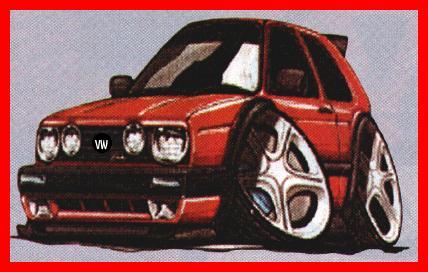Volkswagen Rabbit History!!

The little car that started it all for the next generation of Volkswagens. The year was 1975 and VW sales were dropping. The Japanese auto makers were taking the U.S. market by storm with little economic compact cars cheaper than the VW Beetle. VW’s solution to this , a small economic, compact, Front Wheel Drive, water cooled car. And so it was that the VW Rabbit was born , and there was nothing quite like it on the market. The Rabbit front wheel drive hatches paved the way for small cars in the seventies and eighties. The idea of the Rabbit was quickly copied by several automobile companies.
In 1979 VW started building Rabbits in Pennsylvania. Engines offered for the 1975-1979 period included a 1.6 liter gasoline powered 4-cylinder in either carbureted or fuel-injected form, a 1.5 liter gasoline powered 4-cylinder carbureted, and a 1.5 liter diesel 4-cylinder with fuel injection. The VW Rabbit was offered only as five door or three door hatchback. There were changes made for the late 1979 model year of Rabbit. One of the most noticeable changes made to define the “American” Rabbit were the new square headlights. In 1981, more changes were made to the Rabbit, no more small tail lights, the square headlights got carried over from the previous year, the signal lights in the bumper were replaced with new wrap around signals. The Rabbit's interior got "Americanized" by color keying almost everything inside the car.
In late 1979 for the 1980 model year, the Rabbit pickup, also known as the “Caddy”, was introduced, about 3 feet longer than the Rabbit car, the little truck could haul a lot of stuff and was still economical. It came with a diesel or gas engine, but almost all of them that were sold were diesels.
Also in 1979, Karmann began work on Volkswagen Rabbit Convertible. Having the Rabbit body style, but with a convertible soft top. The Karmann edition Rabbit Convertibles have Karmann emblems on the front fenders. The Rabbit convertible originally came with a 1.6 liter engine when it debuted. In 1984, it was upgraded to a 1.8 liter engine. The Rabbit Convertibles were never manufactured in the USA. They were strictly produced in Germany.
In 1982 the GTI was introduced, a sporty version of the Rabbit. The GTI came with a 1.8 liter engine, stiffer suspension, alloy wheels, front air dam, and special Recaro sport seats. Top speed, acceleration, and handling were improved on the GTI. There's been rumor that a GTI convertible was produced. However, there is no proof of this. All the VW enthusiasts I've questioned concerning a GTI convertible say..."No, one was never produced. Anyone with a convertible that has GTI grill and/or badges is just that.... a Rabbit Convertible or Cabriolet with GTI grill and/or badges." Badges and Grills are swapped out on the Rabbit body styles all the time. GTI is no exception.
Also released in 1982, was the "black tie" edition Rabbit. This Rabbit featured black bumpers and mouldings to dress it up. The interior had special seats, while the outside got a rear wiper.
Available from 1981 to 1984 was a 1.6 liter diesel 4-cylinder engine with optional turbocharger. In 1983 and 1984 VW offered up a 1.7 liter gas 4-cyliner engine with either a carburetor or fuel injection. But at the top of the Rabbit's engine list in power and reliability was the 1.8 liter gas 4-cylinder fuel injecion.
In 1984, the Wolfsburg Edition Rabbit came along. A luxurious Rabbit, that came with a special interior, A/C, and an extra moulding at the bottom of the doors, and other goodies.
Beginning in 1985 the Rabbit Convertible simply became known as the Cabriolet. The Cabriolet eventually developed a more round appearance and was renamed the Cabrio which is still produced today. Which goes to prove that a good Volkswagen never dies, it just bows out gracefully.


Rabbit Page
Mo Carz Main Page
This site is in no way, shape or form affiliated with the or any Volkswagen company. This site is purely for entertainment and personal purposes only.